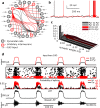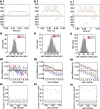Hippocampal CA1 Ripples as Inhibitory Transients
- PMID: 27093059
- PMCID: PMC4836732
- DOI: 10.1371/journal.pcbi.1004880
Hippocampal CA1 Ripples as Inhibitory Transients
Abstract
Memories are stored and consolidated as a result of a dialogue between the hippocampus and cortex during sleep. Neurons active during behavior reactivate in both structures during sleep, in conjunction with characteristic brain oscillations that may form the neural substrate of memory consolidation. In the hippocampus, replay occurs within sharp wave-ripples: short bouts of high-frequency activity in area CA1 caused by excitatory activation from area CA3. In this work, we develop a computational model of ripple generation, motivated by in vivo rat data showing that ripples have a broad frequency distribution, exponential inter-arrival times and yet highly non-variable durations. Our study predicts that ripples are not persistent oscillations but result from a transient network behavior, induced by input from CA3, in which the high frequency synchronous firing of perisomatic interneurons does not depend on the time scale of synaptic inhibition. We found that noise-induced loss of synchrony among CA1 interneurons dynamically constrains individual ripple duration. Our study proposes a novel mechanism of hippocampal ripple generation consistent with a broad range of experimental data, and highlights the role of noise in regulating the duration of input-driven oscillatory spiking in an inhibitory network.
Conflict of interest statement
The authors have declared that no competing interests exist.
Figures








Similar articles
-
Hippocampal Ripple Oscillations and Inhibition-First Network Models: Frequency Dynamics and Response to GABA Modulators.J Neurosci. 2018 Mar 21;38(12):3124-3146. doi: 10.1523/JNEUROSCI.0188-17.2018. Epub 2018 Feb 16. J Neurosci. 2018. PMID: 29453207 Free PMC article.
-
Circuit mechanisms of hippocampal reactivation during sleep.Neurobiol Learn Mem. 2019 Apr;160:98-107. doi: 10.1016/j.nlm.2018.04.018. Epub 2018 May 1. Neurobiol Learn Mem. 2019. PMID: 29723670 Free PMC article.
-
Modeling sharp wave-ripple complexes through a CA3-CA1 network model with chemical synapses.Hippocampus. 2012 May;22(5):995-1017. doi: 10.1002/hipo.20930. Epub 2011 Mar 30. Hippocampus. 2012. PMID: 21452258
-
[Hippocampal ripple oscillations (200 Hz) in mechanisms of memory consolidation].Usp Fiziol Nauk. 2002 Oct-Dec;33(4):34-42. Usp Fiziol Nauk. 2002. PMID: 12449805 Review. Russian.
-
Hippocampal ripples as a mode of communication with cortical and subcortical areas.Hippocampus. 2020 Jan;30(1):39-49. doi: 10.1002/hipo.22997. Epub 2018 Nov 13. Hippocampus. 2020. PMID: 30069976 Review.
Cited by
-
Memory replay in balanced recurrent networks.PLoS Comput Biol. 2017 Jan 30;13(1):e1005359. doi: 10.1371/journal.pcbi.1005359. eCollection 2017 Jan. PLoS Comput Biol. 2017. PMID: 28135266 Free PMC article.
-
Stress enhances hippocampal neuronal synchrony and alters ripple-spike interaction.Neurobiol Stress. 2021 Apr 13;14:100327. doi: 10.1016/j.ynstr.2021.100327. eCollection 2021 May. Neurobiol Stress. 2021. PMID: 33937446 Free PMC article.
-
Hippocampal Ripple Oscillations and Inhibition-First Network Models: Frequency Dynamics and Response to GABA Modulators.J Neurosci. 2018 Mar 21;38(12):3124-3146. doi: 10.1523/JNEUROSCI.0188-17.2018. Epub 2018 Feb 16. J Neurosci. 2018. PMID: 29453207 Free PMC article.
-
Circuit mechanisms of hippocampal reactivation during sleep.Neurobiol Learn Mem. 2019 Apr;160:98-107. doi: 10.1016/j.nlm.2018.04.018. Epub 2018 May 1. Neurobiol Learn Mem. 2019. PMID: 29723670 Free PMC article.
-
Computational analysis of network activity and spatial reach of sharp wave-ripples.PLoS One. 2017 Sep 15;12(9):e0184542. doi: 10.1371/journal.pone.0184542. eCollection 2017. PLoS One. 2017. PMID: 28915251 Free PMC article.
References
-
- Plihal W, Born J. Effects of early and late nocturnal sleep on priming and spatial memory. Psychophysiology. 1999;36(5):571–82. Epub 1999/08/12. . - PubMed
Publication types
MeSH terms
LinkOut - more resources
Full Text Sources
Other Literature Sources
Molecular Biology Databases
Miscellaneous

